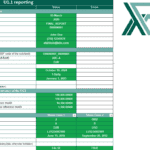What is the CSSF U1.1 reporting?
The CSSF U1.1 report is a regulatory report used by the Commission de Surveillance du Secteur Financier (CSSF 15/627) in Luxembourg. It is a standardized form that must be completed by funds operating in Luxembourg and submitted to the CSSF on a monthly basis.
The reporting obligations apply to all Luxembourg domiciled undertakings for collective investment (UCIs) subject to the law of 17 December 2010, specialised investment funds (SIFs) subject to the law of 13 February 2007 and investment companies in risk capital (SICARs) subject to the law of 15 June 2004.
CSSF U1.1 report is used to provide information about the investment fund, including details about its Net Asset Value, share classes, dividends, performance fees etc.
-
DATA VALIDATION CHECKS
Implement automated validation checks to ensure that the data entered into the Excel template complies with CSSF reporting requirements.
-
SCALABILITY AND FLEXIBILITY FOR ALL DATA FORMATS
Our solution is able to automate the process of gathering and organizing the required information from multiple sources, such as fund accounting systems, portfolio management systems, and trade execution systems.
The solution is able to handle large volumes of data and is able to support the growth of a Management Company business over time.
For small volumetry, we also provide an intuitive Excel template to fulfil.
-
TIMELINESS
Our fully automatic solution enables investment funds to meet the required reporting deadlines and ensure that the reported information is up-to-date.
-
USER FRIENDLY
Design an intuitive and user-friendly interface within Excel to facilitate easy data entry and manipulation for users responsible for completing the report. Include drop-down lists, data pickers, and other UI elements to streamline the input process.
-
FILING
Ready for electronic filing, and ensure compatibility with CSSF’s submission requirements.
Optionaly, we can do the secure filing to the authorities and the feedback fellowship.
-
SUPPORT
Provide documentation, tooltips, and in-app guidance to support users in understanding the reporting requirements and utilizing the features effectively.
To which entities do the reporting obligations apply?
The reporting obligations apply to all Luxembourg domiciled UCIs subject to the law of 17 December 2010, SIFs subject to the law of 13 February 2007 and SICARs subject to the law of 15 June 2004.
What is the reporting frequency?
Reports must be delivered each month, on the tenth calendar day of the month following the reference month at the latest.
What data fields and information need to be included in the report?
- General information on the report and the sender.
- General information on the UCI
- Financial information on the UCI in the base currency of the UCI:
- NAV
- Proceeds from all units/shares issued
- Payments made for all units/shares redeemed
- Total distributions made
- General information on the unit/share class
- Financial information on the unit/share class:
- Number of units/shares outstanding
- Net asset value per unit/share in the base currency of the UCI
- Net asset value per unit/share in the base currency of the unit/share class
- Net return per unit/share in the base currency of the unit/share class
- Proceeds from units/shares issued in the base currency of the UCI
- Payments made for units/shares redeemed in the base currency of the UCI
- Total distributions made in the base currency of the UCI
- Amount of distributions made per unit/share in the base currency of the UC
- Amount of distributions made per unit/share in the base currency of the unit/share class
- Information on investment income and expenses for the reference month in the base currency of the UCI:
- Dividends
- Interest on bonds and other debt securities
- Bank interest
- Other income
- Charges
- Performance fees
- Other expenses
- Net realised profit or loss on investments and foreign exchange positions
- Net unrealised profit or loss on investments and foreign exchange positions
How should data be formatted and structured for submission?
Files must be submitted in XML using a strict naming convention, eg:
U11REP-B00000012-O00008450-00000002-201512-RAP-1421893257541.xml
Reporst must be encrypted and sent using one of the 2 allowed communication channel (SOFiE or E-File), in a near futur using the CSSF S3.
What is the consequence of incorrect or delayed submission?
In accordance with the law, the CSSF has the authority to levy an administrative penalty ranging from EUR 125 to EUR 12,500 if financial reports are not submitted or if additional requested information is not provided, or if the provided information is found to be incomplete, inaccurate, or false.
What exchange rates should I apply for currency conversions?
When reporting figures in a currency different from your UCI’s base currency, use the exchange rate at:
- The booking entry date (for item 5090)
- The valuation date (for items 5030 and 5040)
If your base currency changes during the reference month:
- Report all amounts (except items 5030, 5040, and 5090) in the currency valid at the valuation date (item 2050)
- When submitting your first U1.1 report with the new base currency, convert the amount in item 3010 to the new base currency
When should I submit my first final report?
Submit your first final report (and provisional report if applicable) for the month when either:
- Your NAV is calculated for the first time, OR
- Your first subscription is accepted and units/shares are issued
Note: For the second scenario, you may report an unofficial NAV where item 3020 equals the sum of items 3030 and 3040. Submit a final report once the official NAV is calculated.
When do I submit the first report for a unit/share class?
Submit a final report (and provisional report if needed) when activating a unit/share class during the reference month. Continue providing information for sections 4 and 5 as long as the class remains active, regardless of NAV calculation frequency.
What if my NAV isn’t ready by the 10th calendar day?
You still need to submit a report. Follow this two-step process:
Step 1: Submit a provisional report with estimated figures by the 10th calendar day of the following month
Step 2: Submit a final report with updated figures as soon as they’re available
What should a provisional report contain?
Provisional reports must follow the same validation rules as final reports. If your provisional figures copy the previous month’s total net asset value (item 3020 from item 3010), enter these values:
| Item Numbers | Description | Value |
|---|---|---|
| 3030, 5050 | Proceeds from issued units/shares | 0 |
| 3040, 5060 | Payments for redeemed units/shares | 0 |
| 3050, 5070, 5080, 5090 | Total distributions | 0 |
| 5010 | Outstanding units/shares | Same as previous month |
| 5020, 5030 | NAV per unit/share | Same as previous month |
| 5040 | Net return per unit/share | 0 |
| 6010-6100 | Investment income and expenses | 0 |
When do I submit the last final report for my UCI?
Submit your last final report for the month when your UCI:
- Closes
- Liquidates
- Merges with another UCI
- Abandons UCI status
Required data for the final report:
| Item | Field | Content |
|---|---|---|
| 2080 | Closing date | Date when last investor(s) exit |
| 2090 | Reason for closing | Options: 1, 2, 3, 4, or 5 |
| 3020 | Total NAV | Value of remaining assets in liquidation |
| 3030 | Proceeds from issued units | Proceeds during the reference month |
| 3040 | Payments for redeemed units | Payments during the reference month |
| 3050 | Total distributions | Payments during the reference month |
Merger note: The absorbing UCI should treat converted shares from the absorbed UCI as new subscriptions in item 3030.
Temporary closure: Submit a null report for subsequent months (option 4 in item 2090).
When do I submit the last null report?
Submit your last null report for the month when your UCI definitively closes down.
Required data:
| Item | Field | Content |
|---|---|---|
| 2040 | Legal Entity Identifier | LEI (if available) |
| 2050 | Valuation date | Definitive closure date |
| 2060 | NAV calculation frequency | Options: 1 to 20 |
| 2070 | Launch date | Closure date |
| 2080 | Closing date | Definitive closure date |
| 2090 | Reason for closing | 5 |
Note: The closure date (item 2080) is also reported in items 2050 and 2070.
When does reporting end for a unit/share class?
When a unit/share class is fully redeemed, include it in the U1.1 report for the last time in the redemption month, following these rules:
| Item | Field | Content |
|---|---|---|
| 4060 | Closing date | Date when last investor(s) exit |
| 4070 | Reason for closing | Options: 1, 2, 3, or 4 |
| 5010 | Outstanding units/shares | 0 |
| 5020, 5030 | NAV per unit/share | Last NAV per share |
| 5040 | Net return | Performance from previous and last NAV |
| 5050 | Proceeds from issued units | Proceeds during reference month |
| 5060 | Payments for redeemed units | Payments during reference month |
| 5070, 5080, 5090 | Distributions | Payments during reference month |
How do I report subscriptions and redemptions?
Report all subscription and redemption amounts in the month when they impact the total net asset value (item 3020).
Important: Report contributions in kind or contributions from entities transforming from non-CSSF-authorized to CSSF-authorized UCI as subscriptions (items 3030 and 5050).
How do I report “all-in” fees?
When your fee structure is an “all-in” fee (one compensation amount paid to a recipient who then pays other service providers):
Best practice: Use the same caption as in your annual accounts, based on counterparty status.
Example: “6061 – Advisory and/or management commissions and/or fees”

